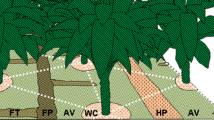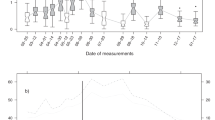Abstract
Background and aims
Lateral tree-scale variability in plantations should be taken into account when scaling up from point samples, but appropriate methods for sampling and calculation have not been defined. Our aim was to define and evaluate such methods.
Methods
We evaluated several existing and new methods, using data for throughfall, root biomass and soil respiration in mature oil palm plantations with equilateral triangular spacing.
Results
Three ways of accounting for spatial variation within the repeating tree unit (a hexagon) were deduced. For visible patch patterns, patches can be delineated and sampled separately. For radial patterns, measurements can be made in radial transects or a triangular portion of the tree unit. For any type of pattern, including unknown patterns, a triangular sampling grid is appropriate. In the case studies examined, throughfall was 79 % of rainfall, with 95 % confidence limits being 62 and 96 % of rainfall. Root biomass and soil respiration, measured on a 35-point grid, varied by an order of magnitude. In zones with steep gradients in parameters, sampling density has a large influence on calculated mean values.
Conclusions
The methods defined here provide a basis for representative sampling and calculation procedures in studies requiring scaling up from point sampling, but more efficient methods are needed.





Similar content being viewed by others
References
Adachi M, Bekku YS, Rashidah W, Okuda T, Koizumi H (2006) Differences in soil respiration between different tropical ecosystems. Appl Soil Ecol 34:258–265
Anuar AR, Goh KJ, Heoh TB, Ahmed OH (2008) Spatial variability of soil inorganic N in a mature oil palm plantation in Sabah, Malaysia. Am J Appl Sci 5:1239–1246
Banabas M, Turner M, Scotter DR, Nelson PN (2008) Losses of nitrogen fertiliser under oil palm in Papua New Guinea: 1. Water balance, and nitrogen in soil solution and runoff. Aust J Soil Res 46:332–339
Brown AJ (1999) Soil sampling and sample handling for chemical analysis. In: Peverill KI, Sparrow LA, Reuter DJ (eds) Soil analysis: an interpretation manual. CSIRO Publishing, Collingwood, pp 35–53
Comte I, Colin F, Whalen JK, Grünberger O, Caliman J-P (2012) Agricultural practices in oil palm plantations and their impact on hydrological changes, nutrient fluxes and water quality in Indonesia: a review. Adv Agron 116:71–124
Corley RHV, Tinker PB (2003) The oil palm, 4th edn. Blackwell Science, Oxford
Davis TA, Mathai AM (1973) A mathematical explanation of foliar spirals in palms. Proc Indian Natl Sci Acad 39A:194–202
Dufrêne E (1989) Photosynthèse, consommation en eau et modélisation de la production chez le palmier à huile (Elaeis guineensis Jacq.). Dissertation, Université de Paris-Sud, Centre d’Orsay
Frazão LA, Paustian K, Pellegrino Cerri CB, Cerri CC (2013) Soil carbon stocks and changes after oil palm introduction in the Brazilian Amazon. GCB Bioenergy 5:384–390
Goh KJ, Härdter R, Fairhurst T (2003) Fertilizing for maximum return. In: Fairhurst T, Härdter R (eds) Oil palm: management for large and sustainable yields. Potash & Phosphate Institute/Potash & Phosphate Institute of Canada and International Potash Institute, Singapore, pp 279–306
Goodrick I, Nelson PN, Banabas M, Wurster C, Bird MI (in press) Soil carbon balance following conversion of grassland to oil palm. GCB Bioenergy
Haron K, Brookes PC, Anderson JM, Zakaria ZZ (1998) Microbial biomass and soil organic matter dynamics in oil palm plantations, West Malaysia. Soil Biol Biochem 30:547–552
Henry P (1955) Note préliminaire sur l’organisation foliaire chez le palmier à huile. Rev Gen Bot 62:127–135
IAEA (1975) Root activity patterns of some tree crops. Technical report series no 170. International Atomic Energy Agency, Vienna
Kuang B, Mahmood HS, Quraishi MZ, Hoogmoed WB, Mouazen AM, van Henten EJ (2012) Sensing soil properties in the laboratory, in situ, and on-line: a review. Adv Agron 114:155–223
Lamade E, Djegui N, Leterme P (1996) Estimation of carbon allocation to the roots from soil respiration measurements of oil palm. Plant Soil 181:329–339
Law MC, Balasundram SK, Husni MHA, Ahmed OH, Hanif Harun M (2009) Spatial variability of soil organic carbon in oil palm. Int J Soil Sci 4:93–103
Mitasova H, Hofierka J (1993) Interpolation by regularized spline with tension: II. Application to terrain modeling and surface geometry analysis. Math Geol 25:657–667
Muzylo A, Llorens P, Valente F, Keizer JJ, Domingo F, Gash JHC (2009) A review of rainfall interception modelling. J Hydrol 370:191–206
Nelson PN, Banabas M, Scotter DR, Webb MJ (2006) Using soil water depletion to measure spatial distribution of root activity in oil palm (Elaeis guineensis Jacq.) plantations. Plant Soil 286:109–121
Nodichao L, Chopart J-L, Roupsard O, Vauclin M, Aké S, Jourdan C (2011) Genotypic variability of oil palm root system distribution in the field. Consequences for water uptake. Plant Soil 341:505–520
Pracilio G, Adams ML, Smettem KRJ, Harper RJ (2006) Determination of spatial distribution patterns of clay and plant available potassium contents in surface soils at the farm scale using high resolution gamma ray spectrometry. Plant Soil 282:67–82
Rankine IR, Fairhurst TH (1998) Field handbook. Oil palm series volume 3. Mature. Potash & Phosphate Institute, Potash & Phosphate Institute of Canada and 4T Consultants, Singapore
Ruer P (1967) Répartition en surface du système radiculaire du palmier a huile. Oléagineux 22:535–537
Sayer J, Ghazoul J, Nelson P, Boedhihartono AK (2012) Oil palm expansion transforms tropical landscapes and livelihoods. Glob Food Secur. doi:10.1016/j.gfs.2012.10.003
Schroth G, Rodrigues MRL, D’Angelo SA (2000) Spatial patterns of nitrogen mineralization, fertilizer distribution and roots explain nitrate leaching from mature Amazonian oil palm plantation. Soil Use Manag 16:222–229
Squire GR (1984) Techniques in environmental physiology of oil palm: partitioning of rainfall above ground. PORIM bulletin 9. Palm Oil Research Institute of Malaysia, Kuala Lumpur
Tinker PBH (1960) Soil heterogeneity and sampling procedure under oil palms. J West Afr Inst Oil Palm Res 4:7–15
Viscarra Rossel RA, Walvoort DJJ, McBratney AB, Janik LJ, Skjemstad JO (2006) Visible, near infrared, mid infrared or combined diffuse reflectance spectroscopy for simultaneous assessment of various soil properties. Geoderma 131:59–75
Von Uexküll H, Henson IE, Fairhurst T (2003) Canopy management to optimise yield. In: Fairhurst T, Härdter R (eds) Oil palm: management for large and sustainable yields. Potash & Phosphate Institute/Potash & Phosphate Institute of Canada and International Potash Institute, Singapore, pp 163–180
Whelan MJ, Anderson JM (1996) Modelling spatial patterns of throughfall and interception loss in a Norway spruce (Picea abies) plantation at the plot scale. J Hydrol 186:335–354
Zaharah AR, Sharifuddin HAH, Ahmad Sahali M, Mohd Hussein MS (1989) Fertilizer placement studies in mature oil palm using isotope technique. Planter, Kuala Lumpur 65:384–388
Acknowledgments
We are grateful to staff of the Papua New Guinea Oil Palm Research Association, who helped carry out the field measurements, Peter Whitehead, who gave mathematical advice, New Britain Palm Oil Ltd., who allowed us access to their plantations, and two anonymous reviewers, who gave several useful suggestions. The work was funded by the Australian Centre for International Agricultural Research (SMCN-2009-013) and the authors’ institutions, including CSIRO’s Sustainable Agriculture Flagship.
Author information
Authors and Affiliations
Corresponding author
Additional information
Responsible Editor: Klaus Butterbach-Bahl.
Rights and permissions
About this article
Cite this article
Nelson, P.N., Webb, M.J., Banabas, M. et al. Methods to account for tree-scale variability in soil- and plant-related parameters in oil palm plantations. Plant Soil 374, 459–471 (2014). https://doi.org/10.1007/s11104-013-1894-7
Received:
Accepted:
Published:
Issue Date:
DOI: https://doi.org/10.1007/s11104-013-1894-7




